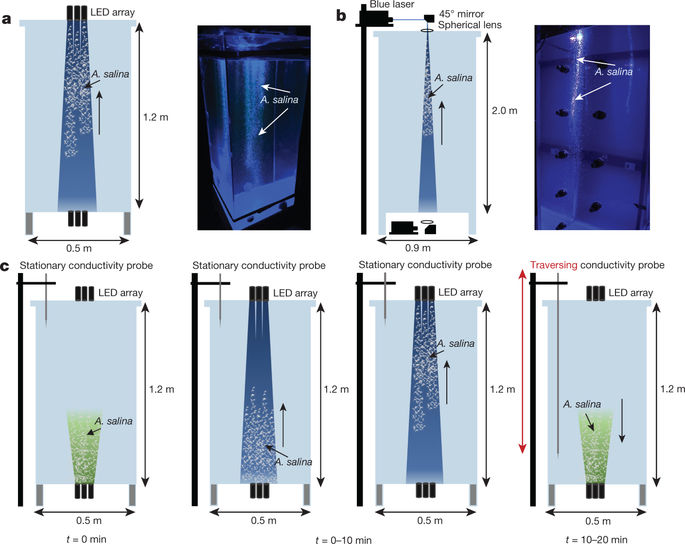Our official English website, www.x-mol.net, welcomes your
feedback! (Note: you will need to create a separate account there.)
Vertically migrating swimmers generate aggregation-scale eddies in a stratified column
Nature ( IF 50.5 ) Pub Date : 2018-04-01 , DOI: 10.1038/s41586-018-0044-z Isabel A. Houghton , Jeffrey R. Koseff , Stephen G. Monismith , John O. Dabiri
Nature ( IF 50.5 ) Pub Date : 2018-04-01 , DOI: 10.1038/s41586-018-0044-z Isabel A. Houghton , Jeffrey R. Koseff , Stephen G. Monismith , John O. Dabiri

|
Biologically generated turbulence has been proposed as an important contributor to nutrient transport and ocean mixing1–3. However, to produce non-negligible transport and mixing, such turbulence must produce eddies at scales comparable to the length scales of stratification in the ocean. It has previously been argued that biologically generated turbulence is limited to the scale of the individual animals involved4, which would make turbulence created by highly abundant centimetre-scale zooplankton such as krill irrelevant to ocean mixing. Their small size notwithstanding, zooplankton form dense aggregations tens of metres in vertical extent as they undergo diurnal vertical migration over hundreds of metres3,5,6. This behaviour potentially introduces additional length scales—such as the scale of the aggregation—that are of relevance to animal interactions with the surrounding water column. Here we show that the collective vertical migration of centimetre-scale swimmers—as represented by the brine shrimp Artemia salina—generates aggregation-scale eddies that mix a stable density stratification, resulting in an effective turbulent diffusivity up to three orders of magnitude larger than the molecular diffusivity of salt. These observed large-scale mixing eddies are the result of flow in the wakes of the individual organisms coalescing to form a large-scale downward jet during upward swimming, even in the presence of a strong density stratification relative to typical values observed in the ocean. The results illustrate the potential for marine zooplankton to considerably alter the physical and biogeochemical structure of the water column, with potentially widespread effects owing to their high abundance in climatically important regions of the ocean7.Laboratory experiments with the brine shrimp Artemia salina illustrate the potential for turbulence generated by the diurnal vertical migrations of aggregations of centimetre-scale zooplankton to affect the physical and biogeochemical structure of oceanic water columns.
中文翻译:

垂直迁移的游泳者在分层柱中产生聚集规模的涡流
生物产生的湍流被认为是营养运输和海洋混合的重要因素1-3。然而,为了产生不可忽视的传输和混合,这种湍流必须在与海洋分层长度尺度相当的尺度上产生涡流。之前有人认为,生物产生的湍流仅限于所涉及的个体动物的规模,这将使磷虾等高度丰富的厘米级浮游动物产生的湍流与海洋混合无关。尽管它们的体型很小,但浮游动物在进行数百米的昼夜垂直迁移时,会在垂直范围内形成数十米的密集聚集体3、5、6。这种行为可能会引入额外的长度尺度——例如聚集的尺度——与动物与周围水柱的相互作用有关。在这里,我们展示了厘米级游泳者的集体垂直迁移——以卤虫卤虫为代表——产生聚集尺度的涡流,混合了稳定的密度分层,导致有效的湍流扩散比大三个数量级。盐的分子扩散率。这些观察到的大规模混合涡流是单个生物体在向上游动期间合并形成大规模向下喷射流的结果,即使存在相对于在海洋中观察到的典型值的强密度分层也是如此。
更新日期:2018-04-01
中文翻译:

垂直迁移的游泳者在分层柱中产生聚集规模的涡流
生物产生的湍流被认为是营养运输和海洋混合的重要因素1-3。然而,为了产生不可忽视的传输和混合,这种湍流必须在与海洋分层长度尺度相当的尺度上产生涡流。之前有人认为,生物产生的湍流仅限于所涉及的个体动物的规模,这将使磷虾等高度丰富的厘米级浮游动物产生的湍流与海洋混合无关。尽管它们的体型很小,但浮游动物在进行数百米的昼夜垂直迁移时,会在垂直范围内形成数十米的密集聚集体3、5、6。这种行为可能会引入额外的长度尺度——例如聚集的尺度——与动物与周围水柱的相互作用有关。在这里,我们展示了厘米级游泳者的集体垂直迁移——以卤虫卤虫为代表——产生聚集尺度的涡流,混合了稳定的密度分层,导致有效的湍流扩散比大三个数量级。盐的分子扩散率。这些观察到的大规模混合涡流是单个生物体在向上游动期间合并形成大规模向下喷射流的结果,即使存在相对于在海洋中观察到的典型值的强密度分层也是如此。











































 京公网安备 11010802027423号
京公网安备 11010802027423号